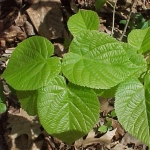| Common Name: |
Linden |
| Botanical Name: |
Tilia cordata |
| Family: |
Tiliaciae |
| Plant Facts: |
Linden can grow to a height of 100 feet and has blooms that have a spicy taste and sweet aroma. The bark on linden is brown to gray and becomes cracked and furrowed with age. The leaves—which were once added to tobacco—are dark green on top and gray-green underneath. |
| Location: |
Europe, North America and Asia |
| Origin: |
Linden trees grow in Europe, North America and Asia in moderate and warm climate zones, in mixed deciduous forests. They are also often planted along city streets, in parks and on large estates. |
| Parts Used: |
The flowers of the linden tree are the part most commonly used for medicinal purposes, and they are almost exclusively imported from Asia. Linden leaves, bark and charcoal are also used in home remedies. |
| Components: |
The flavone glycosides in linden are partially responsible for the herb's valuable sweat-inducing effects; the essential oil of the flowers, containing terpenes, also encourages perspiration. Its high levels of mucins help relieve irritation. Linden also contains tannins, which tighten tissues and promote immunity. |
| Indications: |
Primarily because of its ability to induce sweating, linden-flower tea is used to prevent and treat feverish colds, stubborn coughs and flulike symptoms. Plus, it may relax intestinal and menstrual cramps and aid in strengthening the immune system. Traditional medicine has long relied on linden-flower tea as a gentle tonic for heart and circulatory system. Finally, it is also suitable to give children. |
| Daily Ritual: |
An infusion with linden flowers makes a refreshing toner for the skin. Apply sparingly to soothe and tighten the skin and to help alleviate mild skin irritations. Linden flowers can also be used in steam facials and hair rinses. |
| Methods of Administration: |
- Tea for Inducing Sweat:
To ease a fever, drink the tea as hot as you can tolerate. Pour 1 cup of boiling water over 1-2 tsp. of fresh or dried linden flowers; steep for 10-15 min. Drink 1 cup up to 4 times daily. Sweeten with honey, if desired.
- Calming Bath:
A linden bath will calm the nerves, quiet anxiety and prepare you for restful sleep. Bring 3½ oz. of fresh or dried linden flowers to a boil in about 2 qt. of water. Steep for at least 10 min,; strain and add to your bathwater.
- Poultice for Wounds:
Pour ½ cup of water over 1 cup of dried or fresh linden flowers. Allow leaves to become saturated. Strain, but do not squeeze. Apply the saturated leaves directly on open or poorly healing wounds. Keep a cloth or towel beneath the affected area to soak up extra moisture. Leave on for 20-30 min.
|
| Bibliography: |
The Complete Natural Guide to Healing Copyright © 1999 International Masters Publishers AB™ Group 1 Card 22
|

